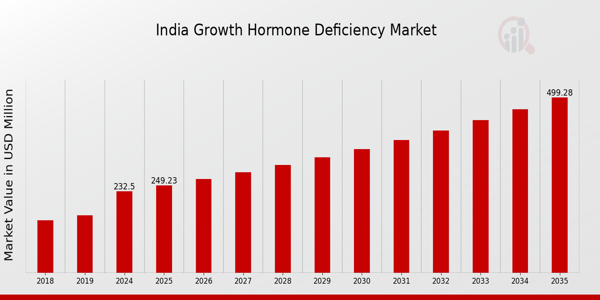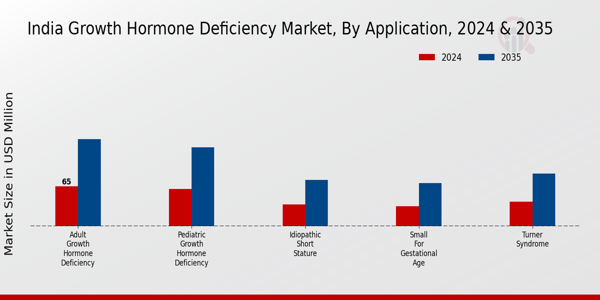India Growth Hormone Deficiency Market Overview
As per MRFR analysis, the India Growth Hormone Deficiency Market Size was estimated at 222.5 (USD Million) in 2023. The India Growth Hormone Deficiency Market Industry is expected to grow from 232.5(USD Million) in 2024 to 499.3 (USD Million) by 2035. The India Growth Hormone Deficiency Market CAGR (growth rate) is expected to be around 7.195% during the forecast period (2025 - 2035)
Key India Growth Hormone Deficiency Market Trends Highlighted
The India Growth Hormone Deficiency Market is experiencing significant trends driven by the rising incidence of growth hormone deficiencies among children and adults in the country. An increasing awareness of hormonal disorders and the vital role of human growth hormone (HGH) in treating such conditions is fostering a surge in demand for hormone therapies. As healthcare accessibility improves, patients and their families are seeking effective treatment options, leading to heightened visibility for growth hormone therapies in both urban and rural areas. There are considerable opportunities to be explored in the Indian market, especially in terms of enhancing therapeutic options and patient education.
Given that many individuals remain unaware of growth hormone deficiency and its implications, there is a market potential for educational campaigns and improved screening practices. Additionally, the advent of advanced technologies in drug delivery systems presents a promising avenue for businesses looking to innovate and capture the interest of healthcare providers and patients alike. Recent trends also indicate a focus on personalized medicine and tailored treatment plans, which aligns with the growing emphasis on patient-centric approaches in India's healthcare system.
This aligns with the government's initiatives towards improving healthcare infrastructure, ensuring that more individuals receive proper diagnosis and management of growth-related conditions.As a result, the market is likely to see an increase in collaborations between pharmaceutical companies and healthcare providers, focusing on comprehensive care solutions for those affected by growth hormone deficiencies in India.

Source: Primary Research, Secondary Research, Market Research Future Database and Analyst Review
India Growth Hormone Deficiency Market Drivers
Rising Awareness and Diagnosis of Growth Hormone Deficiency
In India, knowledge of Growth Hormone Deficiency (GHD) has grown significantly in recent years because of educational initiatives by medical associations like the Endocrine Society. The number of GHD patients identified has increased as more medical professionals are aware of its symptoms. An estimated 1 in 5,000 children receive a GHD diagnosis each year, according to the Indian Society of Paediatric Endocrinology, suggesting that the number of patients in need of therapy is increasing.
By raising the need for growth hormone treatments among both adult and pediatric populations, this development has a direct impact on the growth India hormone deficiency market. This motivation is further supported by government attempts to upgrade diagnostic facilities in the urban and rural healthcare sectors, which will increase impacted persons' access to treatment.
Advancements in Growth Hormone Therapies
The India Growth Hormone Deficiency Market Industry is experiencing substantial growth driven by advancements in growth hormone therapies. Pharmaceutical companies like Eli Lilly and Pfizer are continuously investing in Research and Development to enhance the efficacy and safety profiles of their products.
A recent report indicated that new formulations and delivery methods have shown a 30% increase in patient compliance and treatment adherence. As a result, the availability of innovative therapies has made treatment more attractive to both physicians and patients, thereby fostering market growth.The National Pharmaceutical Pricing Authority (NPPA) in India has also streamlined the approval process for new medications, facilitating faster market entry for these novel therapies.
Increasing Prevalence of Health Disorders Leading to GHD
The growing prevalence of health disorders such as obesity and chronic diseases is driving the demand for treatments for Growth Hormone Deficiency in India. Lifestyle changes and dietary habits have contributed to rising obesity rates, with the Ministry of Health and Family Welfare reporting that approximately 20% of children and 30% of adults are overweight or obese. These conditions can lead to GHD, which in turn increases the need for growth hormone treatments.This correlation highlights a critical market driver for the India Growth Hormone Deficiency Market Industry as healthcare systems seek to address these interconnected health challenges. Moreover, public health initiatives aimed at promoting healthier lifestyles will further amplify the focus on GHD treatment.
India Growth Hormone Deficiency Market Segment Insights
Growth Hormone Deficiency Market Application Insights
The India Growth Hormone Deficiency Market is experiencing a notable transformation, especially within its Application segment. This sector primarily addresses various conditions leading to growth hormone deficiencies, which have garnered significant attention in recent years due to their profound impact on affected individuals and broader healthcare implications. Among the numerous applications, Pediatric Growth Hormone Deficiency stands out as a crucial area, affecting children who do not achieve normal growth, ultimately leading to increased healthcare demands for timely diagnosis and treatment options. Turner Syndrome is another noteworthy application, as it not only underlines the necessity for specific healthcare provisions but also highlights the importance of understanding genetic conditions that exacerbate growth challenges in females.
Additionally, Idiopathic Short Stature represents a vast area within the market, characterized by children whose shortness does not have an identifiable medical reason, creating an opportunity for pharmaceutical advancements and innovative therapies aimed at addressing this growing concern.Small Gestational Age indicates a critical subset of the population where infants are born smaller than expected and may be at risk for long-term growth issues. This aspect of the market emphasizes the importance of early identification and management to prevent ongoing growth hormone deficiencies as these individuals age. Adult Growth Hormone Deficiency also emerges as a significant area of focus, as many adults may experience complications due to a lack of growth hormone, leading to implications not only for their physical health but also for their overall quality of life, thus creating a growing market for effective treatments.
Prader-Willi Syndrome, characterized by a range of physical and behavioral challenges, further enriches the landscape of the India Growth Hormone Deficiency Market. The distinct medical needs of individuals with this condition often require specialized approaches, which makes it a vital area for continued research and development. Lastly, the 'Others' category encompasses a variety of additional conditions that may not fit neatly into the aforementioned segments, yet it plays an integral role in understanding the overall growth hormone deficiency landscape.The market is expected to grow due to various drivers, such as increasing awareness of growth disorders among healthcare professionals and the general population, advancements in medical technology, and policy initiatives aimed at improving access to treatment.
However, it faces challenges such as high costs associated with treatments and variations in healthcare infrastructure across different regions in India. Overall, this segmentation emphasizes not only the complexities involved in managing growth hormone deficiencies but also the opportunities that lie in enhancing healthcare solutions for affected individuals. Addressing these segments holistically can pave the way for innovative solutions that cater to the needs of a diverse patient population throughout India.

Source: Primary Research, Secondary Research, Market Research Future Database and Analyst Review
Growth Hormone Deficiency Market Route of Administration Insights
The Route of Administration segment in the India Growth Hormone Deficiency Market holds a critical role in the effective delivery of therapeutics designed to manage this condition. The predominant methods include Subcutaneous, Intravenous, and Intramuscular administration, each offering distinct advantages. Subcutaneous administration is widely preferred due to its ease of use and patient comfort, as it allows for self-administration, thus encouraging adherence to treatment protocols. Intravenous delivery, while less common for routine use, provides rapid therapeutic effects, making it suitable for acute situations or hospital settings.
Intramuscular administration also remains significant in clinical practice, often utilized for patients who may require higher doses or specific formulations. As the prevalence of Growth Hormone Deficiency continues to rise in India, driven by factors such as lifestyle changes and genetic predispositions, the demand for effective delivery methods will likely grow. The India Growth Hormone Deficiency Market data indicates a steady increase in awareness and diagnosis, prompting opportunities for innovation in delivery technologies to enhance patient experiences.
The growth trends reflect a growing focus on patient-centric approaches, signifying that the Route of Administration will continue to evolve in response to regulatory guidelines and market needs. This dynamic environment presents unique challenges and opportunities that stakeholders in the India Growth Hormone Deficiency Market must navigate.
Growth Hormone Deficiency Market Distribution Channel Insights
The Distribution Channel segment plays a crucial role in the India Growth Hormone Deficiency Market, facilitating access to vital treatments for patients. Hospital Pharmacies are central to patient care, offering specialized services and rapid dispensing of essential medications, ensuring healthcare professionals can swiftly address patients’ needs. Retail Pharmacies contribute significantly by being accessible to the community and providing a convenient option for patients and caregivers.
Online Pharmacies have emerged as a growing trend, reflecting the increasing shift towards digital transactions, allowing for easier access and the potential to reach a broader audience, particularly in urban areas where convenience is key.Specialty Pharmacies focus specifically on complex medication regimens and provide tailored support to patients, helping to manage the intricacies of Growth Hormone Deficiency treatments. The importance of these distribution channels cannot be overstated; they each serve distinct roles that cater to varying patient needs, ensuring that effective therapies are readily available across different demographics in India.
Collectively, these channels enhance the overall accessibility and efficiency of the India Growth Hormone Deficiency Market, reflecting a trend towards improved patient engagement and a comprehensive approach to healthcare delivery.
Growth Hormone Deficiency Market Brand Insights
The India Growth Hormone Deficiency Market, particularly under the Brand segment, presents a diverse landscape driven by key players such as Norditropin, Genotropin, Humatrope, Saizen, and Omnitrope. Each brand offers unique formulations and delivery methods, catering to the specific needs of patients suffering from growth hormone deficiencies. The presence of these established brands provides a competitive edge, with each contributing to increased awareness and treatment availability across India.
Norditropin and Genotropin, with their innovative delivery mechanisms, are significant in promoting patient adherence, while Humatrope and Saizen have been recognized for their effectiveness in treating various forms of growth hormone deficiencies.The market sees a growing demand due to heightened awareness of growth disorders along with advancements in manufacturing processes, enhancing the availability of these products. Emerging brands and formulations are also entering the space, showcasing opportunities for market expansion.
The ongoing Research and Development activities aimed at enhancing efficacy and minimizing side effects further bolster the growth of the India Growth Hormone Deficiency Market, making it a focal point for stakeholders and investors. Overall, the Brand segment plays a crucial role in shaping the treatment landscape and meeting the evolving needs of the patient population in India.
India Growth Hormone Deficiency Market Key Players and Competitive Insights
The India Growth Hormone Deficiency Market is experiencing significant growth due to increasing awareness about growth disorders and advancements in treatment options. The market landscape is characterized by a mix of established and emerging players who are striving to capture market share through innovative products and strategic collaborations. With a rising incidence of growth hormone deficiency among pediatric populations due to factors such as genetic disorders and environmental influences, the competitive dynamics are shifting. Furthermore, the growing healthcare infrastructure in India, coupled with government initiatives aimed at improving access to healthcare, is also propelling the growth of this market segment.
Companies are focusing on enhancing their product offerings, engaging in partnerships, and expanding their reach to cater to the increasing demand for effective growth hormone therapies.Eli Lilly has a strong position in the India Growth Hormone Deficiency Market, leveraging its extensive experience in the pharmaceutical industry to deliver high-quality growth hormone products. The company's brand reputation is bolstered by its commitment to research and innovation, enabling it to provide cutting-edge therapies that address the specific needs of patients in India.
Eli Lilly has efficiently established its market presence through targeted marketing strategies and collaborations with healthcare professionals to raise awareness around growth disorders. Its strengths lie in its robust distribution network, comprehensive support programs for patients, and focus on patient-centered care, further solidifying its position as a trusted leader in this segment.Sandoz plays a significant role in the India Growth Hormone Deficiency Market, offering a range of biopharmaceuticals known for their efficacy and safety. The company is recognized for its commitment to affordability and access, providing cost-effective alternatives for growth hormone therapies that cater to the needs of the Indian market.
Sandoz's key products in this sector include recombinant growth hormone therapies that underpin its market presence. The strengths of Sandoz include a highly efficient supply chain and established partnerships with healthcare institutions. The company's focus on sustainability and innovation, combined with its strategic mergers and acquisitions, has positioned Sandoz favorably within the Indian market, allowing it to continually enhance its product portfolio and expand its reach, aligning effectively with the country's increasing demand for specialized healthcare solutions.
Key Companies in the India Growth Hormone Deficiency Market Include
India Growth Hormone Deficiency Market Industry Developments
Recent developments in the India Growth Hormone Deficiency Market have shown promising growth and significant activity among key players. Companies such as Eli Lilly, Novo Nordisk, and Pfizer are enhancing their market presence through strategic initiatives. Notably, in July 2023, Sandoz announced an expansion of its biosimilar portfolio in India, aiming to provide more affordable treatment options for patients struggling with growth hormone deficiency. Current affairs highlight the increasing awareness and diagnosis rates, largely driven by initiatives from the Indian government to improve childhood health and growth standards.
Mergers and acquisitions have also marked this period; for example, in August 2023, Ferring Pharmaceuticals acquired recent patents related to synthetic growth hormones to consolidate its position in the market, firmly backed by multiple industry discussions. Over the past two years, the India growth hormone market has witnessed a valuation increase driven by improved healthcare infrastructure and greater accessibility to treatment options.
Major happenings include the launch of novel therapies targeting specific demographics in May 2022 that heightened interest in personalized medicine frameworks within this field. Overall, the competitive landscape continues to evolve, driven by innovation and shifts in policy emphasizing patient care and health improvement initiatives.
India Growth Hormone Deficiency Market Segmentation Insights
-
Growth Hormone Deficiency Market Application Outlook
- Pediatric Growth Hormone Deficiency
- Small for Gestational Age
- Adult Growth Hormone Deficiency
-
Growth Hormone Deficiency Market Route of Administration Outlook
-
Growth Hormone Deficiency Market Distribution Channel Outlook
-
Growth Hormone Deficiency Market Brand Outlook
| Report Attribute/Metric Source: |
Details |
| MARKET SIZE 2023 |
222.5(USD Million) |
| MARKET SIZE 2024 |
232.5(USD Million) |
| MARKET SIZE 2035 |
499.3(USD Million) |
| COMPOUND ANNUAL GROWTH RATE (CAGR) |
7.195% (2025 - 2035) |
| REPORT COVERAGE |
Revenue Forecast, Competitive Landscape, Growth Factors, and Trends |
| BASE YEAR |
2024 |
| MARKET FORECAST PERIOD |
2025 - 2035 |
| HISTORICAL DATA |
2019 - 2024 |
| MARKET FORECAST UNITS |
USD Million |
| KEY COMPANIES PROFILED |
Eli Lilly, Sandoz, Ferring Pharmaceuticals, Boehringer Ingelheim, Novo Nordisk, Pfizer, Ipsen, Haitian Biotech, Amgen, Roche, Merck Serono, Genotropin, Mylan, Anhui Zhifei Longcom, Ascendis Pharma |
| SEGMENTS COVERED |
Application, Route of Administration, Distribution Channel, Brand |
| KEY MARKET OPPORTUNITIES |
Increased awareness among healthcare providers, Rising prevalence of obesity and diabetes, Growth in pediatric applications, Advancements in drug delivery systems, Expansion of online healthcare services |
| KEY MARKET DYNAMICS |
Increasing diagnosis rates, Rising awareness among patients, Availability of advanced treatments, Growing healthcare expenditure, Supportive government policies |
| COUNTRIES COVERED |
India |
Frequently Asked Questions (FAQ):
The India Growth Hormone Deficiency Market is expected to be valued at 232.5 million USD in 2024.
By 2035, the market is projected to reach a value of 499.3 million USD.
The market is expected to grow at a CAGR of 7.195% during the forecast period from 2025 to 2035.
The Pediatric Growth Hormone Deficiency segment is projected to be the largest application, valued at 60.0 million USD in 2024.
The Turner Syndrome application is expected to reach a market size of 85.0 million USD by 2035.
Key players include Eli Lilly, Sandoz, Ferring Pharmaceuticals, Boehringer Ingelheim, and Novo Nordisk.
The Adult Growth Hormone Deficiency application is valued at 65.0 million USD in 2024.
By 2035, the Idiopathic Short Stature application is anticipated to reach a market value of 75.0 million USD.
Growing awareness and increased diagnosis of growth disorders are primary growth drivers for the market.
The Small for Gestational Age application is expected to be valued at 32.5 million USD in 2024.
















